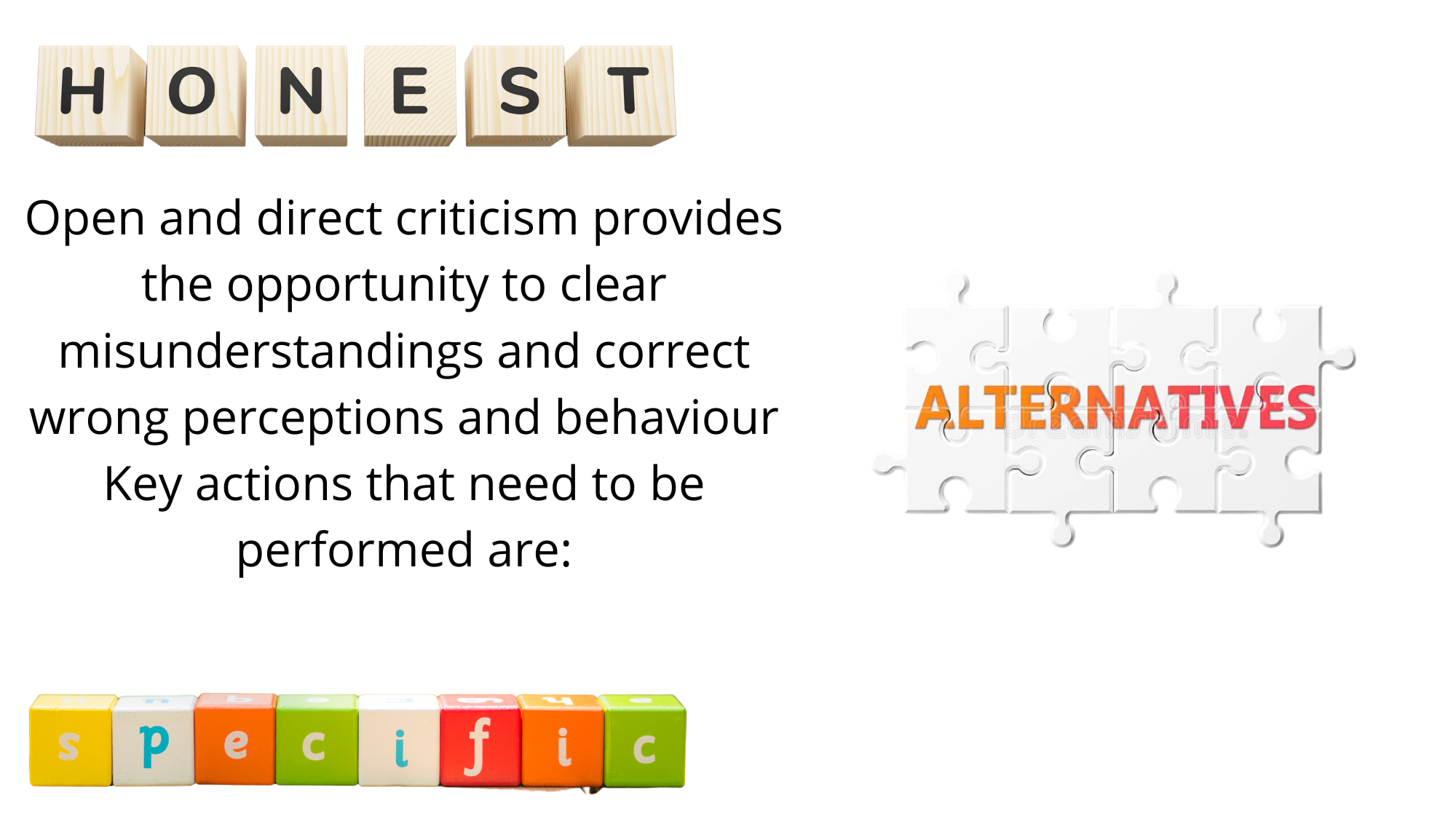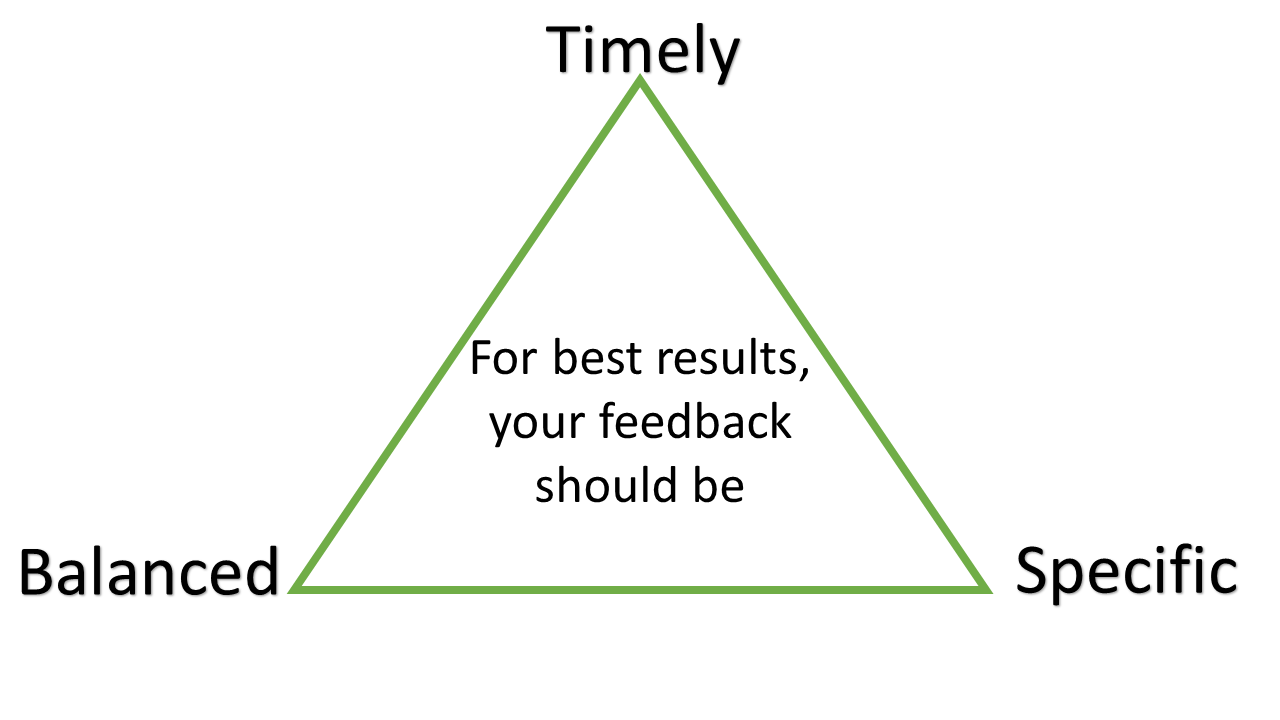Regularly provide and record feedback to the individual and/or the team on progress or lack thereof.
Feedback is the process according to which you receive information from the external environment on both the positive and negative aspects of your performance. Feedback provides an answer to the question “How am I doing?"

Another important aspect of performance and development management is the aspect of giving and receiving feedback. Feedback answers the question: ‘How am I doing?’
Once people agree to achieve certain goals and objectives they need to know how well they are doing.
Click here to view a video that explains how to give feedback.
Constructive feedback on performance is important because it encourages and motivates employees to perform at acceptable standards. It also helps correct mistakes and solves problems; it builds relationships between people, saves money and provides direction. People participating in a performance management process, both managers/supervisors and staff members, need to know how to provide constructive feedback to fellow employees as well as how to receive feedback in such a manner that it will have a positive effect on performance. Open and direct criticism provides the opportunity to clear misunderstandings and correct wrong perceptions and behaviour.
Key actions that need to be performed are:
Be honest, but maintain the person’s self esteem by providing balanced feedback. Begin and end with a positive statement. People are more receptive to corrective feedback when it is mixed with positive comments.
Be specific about what was said or done and state why it was effective or ineffective. Give examples of how the situation could have been handled more effectively.
Offer alternatives. If you are giving feedback for improvement, tell the person what he or she could have said or done differently; your perspective will be helpful. Your feedback has more value and credibility when you show that you have thought of other ways to deal with the situation.

NOTE: Because employees monitor their own performance in this process, they receive much of their feedback directly, using monitoring methods established during the planning phase. As a result, they can take action whenever necessary to stay on target towards these objectives.
In addition to data from own monitoring sources, staff members also depend on managers/supervisors for information. When they perform effectively or need to improve, you need to tell them and provide specific feedback on what they did well and what they did not do so well. Your feedback is important. It helps determine whether individuals meet objectives. For best results, your feedback should be timely, balanced and specific.
Timely Feedback
Provide feedback as soon as possible after the incident occurs. Feedback today on something that happened this morning means much more than feedback tomorrow or the following week. The incident is still fresh in the person’s mind, so feedback will be more meaningful.
Balanced Feedback
Mix positive and constructive comments throughout the discussion where possible. Too much negative feedback might make people defensive and unwilling to communicate. If you recognise all the good performance in the beginning and leave the corrective feedback for the end, a person might feel ‘set up’. Disappointment and resentment might then replace any feeling of satisfaction. After giving corrective feedback, end the discussion with a plan for improving performance. Work closely with the staff member on the plan. The more the individual contributes to it, the more committed she will be to carry it out
Specific Feedback
A vague comment like “You could have done a better job on that report”, does not identify the problem. It does not indicate what was wrong and how to improve. It is not the type of feedback that will help someone achieve his or her objectives. Along the same vein, general praise like “You have done a good job on that report”, also does not specify what the individual die well and should continue doing. Specific feedback explains what the individual did and why it as effective or ineffective.


When the performance is poor:
- Clearly establish competence gaps and poor performance.
- Explore possible reasons for the poor performance.
- Consider possible solutions and ways to remedy the situation.
- Consider possible training and development opportunities.
When the performance is good:
- Recognise good performance clearly.
- Explore possible reasons for good performance.
- Explore ways in which the good performance can be maintained and enhanced.
- Revise performance goals and objectives to ensure that they stay challenging and stretch the individual to perform even better.
- Consider development opportunities to develop skills further.

Seek Information on Possible Reasons for Departure From Standards.
Individual performance needs to be analysed in order to optimise future performance.
It is not enough to just know that performance standards have not been met. Both you and the employee need to understand why performance standards have not been achieved. What are the underlying reasons? There might be a common denominator.
Analyse all the areas in which performance objectives were not met. Look for an underlying reason by exploring the matter with the staff member. You might find that the individual is lacking certain core competencies or skills. There might be health problems, family problems, motivation problems, etc. It is also possible that there might be a mismatch between the person and the job. To assist you, you could potentially also look at what makes other incumbents successful while this staff member does not perform, in order to establish the gap.
Make a list of all the possible reasons for departure from the standard. Is there a common underlying reason? What is the bottom line? Once you have analysed the performance thoroughly, you will be in a position to establish an action plan aimed at addressing the gaps.
Click here to view a video that explains how to communicate your assessment of an employee's poor performance.
Click here to view a video that explains how to coaching poor performance.